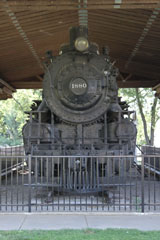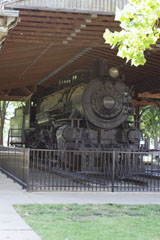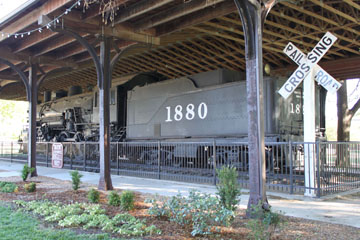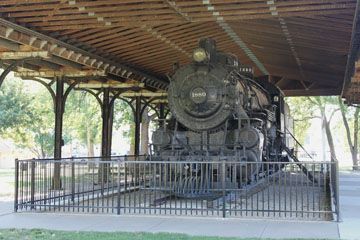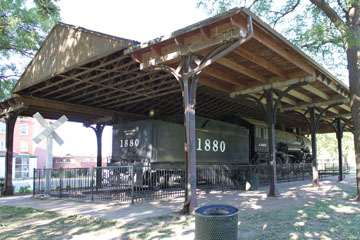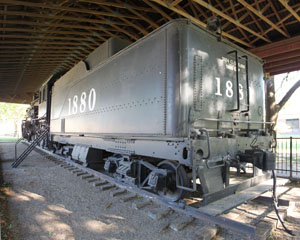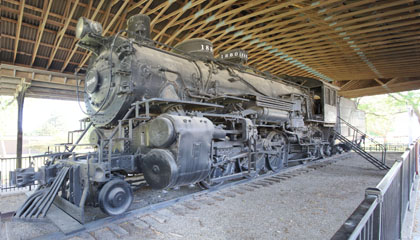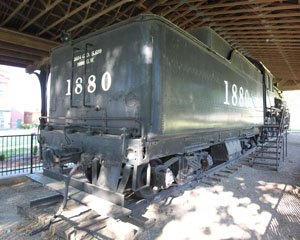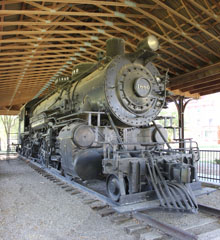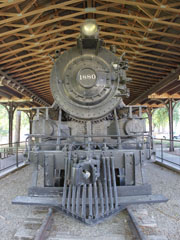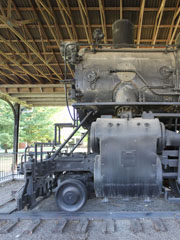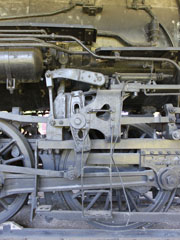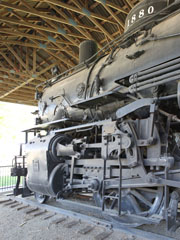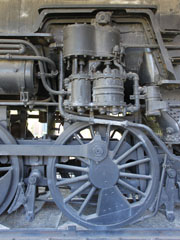

Built by Baldwin, this is one of thirty-one Prairie type
(2-6-2) locomotives delivered to the AT&SF in 1907 (#1857-#1887). They each cost $24,500 and were amongst the largest 2-6-2s to operate in the US.
Built as Vauclain compounds, with 18" x 28" high pressure and 28" x 28" low pressure cylinders, they had slightly larger cylinders than the fifty-seven 1800 class locomotives built by Baldwin in 1903 (#1800-#1856), but were otherwise the same design, including having
inside high pressure cylinders raked to 7° off the horizontal to clear the front axle and avoid using a
forked main rod. The engine had two pistons mounted in line and moving in parallel to drive a common crosshead. The valve was on the inside, controlled by Stephenson valve gear.
The main advantage claimed for compounding was lower fuel and water consumption, but the Vauclain arrangement produced uneven forces and excess wear at the crosshead, which increased maintenance costs and largely offset any fuel economies. The complex valve assembly and the starter valve, which allowed admission of high pressure steam directly to the low pressure cylinder, also increased maintenance costs.
By the turn of the century, many US railroads were turning away from compounds and converting those they already owned to single-expansion locomotives. The AT&SF subsequently simpled all its 1800s and 1857s between 1926 and 1929 with 25" x 28" cylinders.
Like many other simple locomotives in the US, the 1800s and 1857s were subsequently superheated during the 1920s, increasing #1880's weight by 11,932 lbs to 260,132 lbs. The locomotive's weight on its 69" drivers also rose from 174,700 lbs to 179,006 lbs.
Originally a coal burner, #1880 was converted to burn oil in 1941. It has a 57.3 sq ft grate and 246 sq ft firebox. With a total heating surface of 4,084 sq ft, including 802 sq ft superheating, it operated at a boiler pressure of 225 psi delivering 36,978 lbs tractive effort.
#1880 hauled freight on AT&SF's Missouri, Eastern,
Kansas Southern and Middle Divisions, although it
operated mainly in the state of Kansas, clocking up 1,022,667 miles before being retired in 1953. It then sat for two years in the Emporia, KS, rail yard until Newton's Junior Jaycees mounted a campaign to secure the engine for the city.
After being converted to burn oil, #1880s original tender was replaced with the current 199,200 lb one. It has a capacity of 9,000 gallons of water and 3,904 gallons of oil.
#1880 was donated to the City of Newton in 1955 and hauled by an AT&SF crew on temporary rails from the railroad track on West Broadway to its current site in Military Park on East Broadway. The canopy is from the original AT&SF depot building in Newton.


